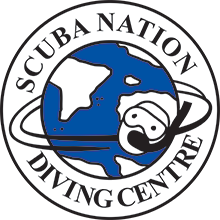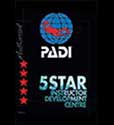Koh Rong Saloem
 Koh Rong Saloem is situated around 1½-2 hours from the mainland and south of Koh Kon, but is a much bigger island comprising 3 major beaches and several other minor ones.
Koh Rong Saloem is situated around 1½-2 hours from the mainland and south of Koh Kon, but is a much bigger island comprising 3 major beaches and several other minor ones.
There is a small fishing village at the very north end, and a few other bungalow resorts dotted around and it still provides perfect secluded beaches and exclusive diving. Visibility ranges from 5-25m but is usually around 10m.
1. Cobia Point
As its name suggests, this place tends to attract a lot of cobia (kingfish). These are large fish up to 2m long and resemble grey reef sharks. Although they’re non-harmful, they are very curious and often hang around the divers for much of the dive, which can be a bit unnerving if you don’t know what they are! Stunning corals line the cliff face here which plunges quite steeply from the shore to around 18m. The site itself often has a current and is usually a drift dive.
2. Rocky Bay
This is a more sheltered site ideal for taking your time to look closely at the corals and abundant fish life. As the maximum depth is around 10m, you’re able to get a nice long dive. This is a great site for macro-life with many nudibranch, pipe fish, crustaceans and juvenile fish.
3. Nudibranch Heaven
Unsurprisingly, this dive site features many different types of nudibranch. Again, a fairly shallow dive site, the reef gradually falling from the shore to a max of 10m, this site shelters many cuttlefish, pufferfish, moray eels and small octopus. Several types of rays are often to be found here as well as schools of damsel and parrot fish.
4. Sponge Garden
This site is named after the many large barrel sponges which abound along the reef here. Inside the sponges you can find scorpionfish, lion fish and many shrimp and crabs. The reef drops from the shoreline to around 10m closer to the beach and extends to 17m further out. We find cobia here too as well as barracuda. There are schools of yellow goatfish and parrotfish , which are often so thick it’s like a wall of fish blocking the view of the brightly coloured reef.
5. Two Tone Garden
As its name implies, this site almost splits into 2 different dive experiences. The first diving closer to shore is characterized by reef to around 12m with many large coral bommies and formations and an abundance of fish life. As you drift further out the reef becomes more shallow and gives way to great pink fields of anemones and whip coral, usually with amazing visibility. This is a great night dive site with blue-spotted sting rays, scorpionfish and many marine worms and crustaceans.
6. Victoria’s Secret Garden
A well-hidden site and easy to miss, this is a narrow strip of off-shore reef which runs along at about a 10m depth. The site itself often has a mild current and is usually a drift dive. It sports stunning soft corals and well as a profusion of brilliant marine life.
7. Last Chance
This site boasts corals stepping down to around 15m. There are many puffer fish and rays hidden among the corals as well as box fish and scorpionfish. There is also a small fishing boat wreck which is usually surrounded by schooling fish.
8. M’Pay Bay
This is one of the largest bays on the island, situated to the north, and has several dives sites within it. There is a shallow coral reef in the centre which goes to around 6-7m and is perfect for try diving or dive training. Smaller fish congregate all over the reef. Further around the bay there is a fishing boat wreck usually swarming with schooling fish. There are also large sandy areas that are perfect for seeing more unusual invertebrates as well as octopus and squid hunting on night dives. Further out between the islands, there is a deeper drop off with the chance of larger schooling fish and more unusual critters over the sand.
9. Fab Point
Looping round M’Pay bay heading east is Fab Point which is a fringe reef dive down to around 10m. Expect to see loads of macro stuff, nudibranch, octopus etc. There are also scorpionfish and blue-spotted rays hiding in amongst the corals.



